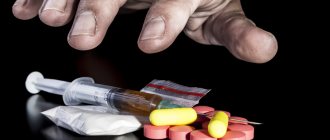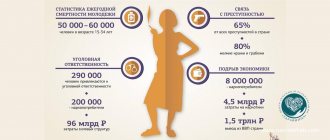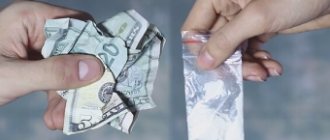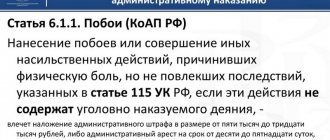In the Soviet Union, drug use was less common than it is today, but the punishment for this act was more severe. It consisted of being sent to compulsory correctional labor (for a period of 1 year), as well as imprisonment.
In the Russian Federation, the use of drugs is prohibited; liability for these actions is more lenient - it is considered an administrative offense. To determine what falls under these articles, it is necessary to understand what drugs are in general.
You may be arrested for using it
The Code of Administrative Offenses has several articles that provide for liability for illegal (that is, without a doctor’s prescription) use of narcotic drugs:
Article 6.9 Code of Administrative Offenses of the Russian Federation
According to this norm, those who have used the drug at home, that is, not in a public place, are involved. Punishment can be either a fine (from 4,000 to 5,000 rubles) or arrest for up to 15 days . Administrative cases of this kind are considered by the court (like all others related to illegal trafficking), and the statute of limitations for the offense is not 2 months, as in ordinary administrative offenses, but 1 year.
Of course, in order to find a person guilty under Art. 6.9 of the Code of Administrative Offenses of the Russian Federation, you need to have strong evidence that he is in a state of drug intoxication. To do this, at the request of law enforcement agencies, a person raising suspicions of adequacy is sent for a medical examination. The law, practice materials, as well as the regulations of the Ministry of Internal Affairs contain clarifications under what circumstances a referral for examination will be considered justified:
- unsteady gait;
- slurred speech;
- lethargy or, conversely, aggression;
- appearance, behavior or other criteria that give reason to consider a person to be intoxicated (for example, lying on the road, climbing trees, defiantly undressing in a public place, etc. - manifestations of inadequacy may be different).
If the listed signs are present, and the citizen categorically refuses to undergo an examination, such refusal is automatically equated to liability under Art. 6.9 of the Code of Administrative Offenses of the Russian Federation, as if intoxication had been established.
Example No. 1 . When checking the storage of hunting weapons, the district police officer visited K.O. Korneev’s place of residence to verify the presence of a safe. The door was opened by Korneev K.O., who was in an inadequate state, the pupils of his eyes were dilated, his speech was accompanied by minute pauses and twitching of his limbs. The district police officer suggested that Korneev go to the drug treatment clinic to undergo a medical examination for drug use, but he refused. As a result, Korneev was not only brought to administrative responsibility for using under Art. 6.9 of the Code of Administrative Offenses of the Russian Federation, but was subsequently deprived of a license to store and carry hunting weapons.
In administrative practice in cases of traffic violations, drivers who refuse to undergo examination are often held liable not only under Part 1 of Art. 12.8 of the Code of Administrative Offenses of the Russian Federation, but also for use under Art. 6.9 Code of Administrative Offenses of the Russian Federation at the same time. In most cases, such drivers do not agree with “double” responsibility, believing that they were unfairly punished for the same offense, and appeal the judge’s decisions. At the same time, the Supreme Court of the Russian Federation, in its clarifications, as well as the Constitutional Court of the Russian Federation, which considers complaints regarding the compliance of these norms with the Constitution of the Russian Federation, came to the conclusion that it is legal to bring to justice simultaneously under two norms, considering the actions of the perpetrator falling under each article, independent and separate from each other.
According to Part 2 of Art. 6.9. The Code of Administrative Offenses of the Russian Federation is held responsible for the same actions by citizens of another state or stateless persons: for them, the punishment is supplemented by mandatory administrative deportation from the Russian Federation.
The note to the article contains special rules for the release from liability of those who are recognized as drug addicts and wish to receive treatment:
- if a citizen independently seeks medical help in connection with dependence on narcotic or psychotropic substances, thereby, in essence, admitting himself guilty of use;
- if a citizen is already recognized as a drug addict, he can be referred for treatment by law enforcement agencies (an appropriate resolution is issued).
In both cases from administrative liability under Art. 6.9 of the Code of Administrative Offenses of the Russian Federation, a person is released.
Part 2 of Article 20.20 of the Code of Administrative Offenses of the Russian Federation
A citizen who uses prohibited substances in a public place - on the street, in a park, in a cafe, club, cinema, etc. can become guilty under this provision. Despite the fact that this type of offense is more socially dangerous than actions under Art. 6.9 of the Code of Administrative Offenses of the Russian Federation, the punishment for it is the same: a fine from 4000 to 5000 rubles, arrest for up to 15 days . In relation to foreign citizens in part 3 of Art. 20.20 of the Code of Administrative Offenses of the Russian Federation additionally provides for expulsion.
The police officer must have sufficient facts confirming the person’s use of a drug or psychotropic substance in a public place. In addition, if there is evidence of this, and the citizen refuses to undergo examination, he will be held accountable according to the same standard as if he had used a prohibited substance in a public place.
Example No. 2 . Egorov K.Yu. I was at the city stadium, at the match of my favorite football team. Stepping aside, Egorov decided to take a tablet of a psychotropic substance, but was noticed by one of the PPSP employees of the Ministry of Internal Affairs, performing security functions. Since the stadium is a public place, and the fact that Yegorov was using a narcotic substance was noticed, he was asked to go for an examination to identify his state of intoxication. Egorov refused, for which he was held accountable under Part 2 of Art. 20.20 Code of Administrative Offenses of the Russian Federation, he was sentenced to 10 days of arrest.
Article 20.22 of the Code of Administrative Offenses of the Russian Federation
Parents or legal representatives of children who have used drugs are responsible for this. In essence, in this way the legislator punishes irresponsible parents for improper upbringing of minors. It often happens that these parents themselves suffer from addiction and lead a corresponding, far from exemplary, lifestyle.
If a child is found to be under the influence of drugs, mom and dad may be subject to a fine of 1,500 to 2,000 rubles . In addition, if repeated facts of improper upbringing of a child are established, parents may be deprived of parental rights at the request of the guardianship and trusteeship authority.
Article 20.21 Code of Administrative Offenses of the Russian Federation
According to this standard, a fine of 500 rubles to 1,500 rubles can be imposed , as well as arrest for up to 15 days for appearing in a public place (park, square, public transport) while intoxicated. The law does not specify what kind of intoxication - alcohol or drugs. According to the explanations of the Supreme Court of the Russian Federation, there will be liability in both cases - judicial practice follows the same path. Moreover, in the event of a refusal to undergo a medical examination, it is impossible to establish whether the person was drinking or using drugs, but his inadequate condition and inhibited behavior give rise to prosecution and subsequent punishment for appearing in such a manner in society.
Along with narcotic and psychotropic substances, the difference between which is in the effect on the body, in the negative consequences and method of production, all the above norms of administrative legislation indicate the so-called new psychoactive substances. There is no official list of these substances, but they are also prohibited. We are talking about so-called soft drugs that can be used like regular chewing gum. Many schoolchildren are familiar with nasvay - an extremely dangerous and harmful substance for the children's brain, but at the same time practically accessible to the public. Nasvay is not included in the lists of prohibited substances approved by the Government of the Russian Federation, however, this substance has a very active effect on the central nervous system of the child and is persistently addictive. The use of nasvay is prohibited by law and entails liability according to the above norms of the Code of Administrative Offenses of the Russian Federation. To prevent addiction to this substance, school and city administrations carry out preventive measures, but parents, in turn, are obliged to be extremely attentive to their offspring.
Symptoms of drug intoxication
Symptoms may depend on the type of drug a person has used, but there are several common signs that are common to most substances.
- Behavior and appearance resemble a state of alcoholic intoxication, but there is no characteristic smell of alcohol.
- Change of consciousness. It can manifest itself in different ways: from a sleepy state to deafness, lack of understanding of what is happening.
- Changes in the psycho-emotional sphere. They are characterized by disinhibition, fun, and euphoria, but sudden mood swings can also occur.
- Features of motor activity. Expressive gestures, inability to sit still. It can also manifest itself as lethargy and relaxation. Coordination of movements is changed: staggering, impaired motor skills, trembling of arms and legs.
- Speech disorders. Poor articulation, slurring, or overexpression.
- External changes:
- the color of the skin acquires a reddish tint or becomes unnaturally pale;
- when intoxicated with opiates, the pupils become narrow, in many other cases they dilate;
- the shine in the eyes is increased, redness of the eyes and swelling of the upper eyelids may also occur.
The use of psychoactive substances causes persistent dependence, which subsequently requires the use of comprehensive drug addiction treatment. In addition, these actions are fraught with liability under several articles.
Is there an addiction problem in the family?
Sign up for a free consultation right now, we will help you!
Inducement to use
We have already noted that the Criminal Code of the Russian Federation does not contain provisions on criminal liability for drug use.
At the same time, inducing other people to use is a criminal offense in accordance with Art. 230 of the Criminal Code of the Russian Federation.
This provision of the law makes it possible to hold accountable those who introduce healthy people to drug addiction, contributing to the emergence of addiction. According to research, drug addicts are divided into two groups - those who deeply regret that they once tried a prohibited substance (such addicts, despite the fact that they themselves continue to use, discourage people who decide to try it for the first time) and those who actively distribute information about the imaginary safety of drugs, offers and even imposes pills and mixtures on the “newbie”.
Inducement to try a drug may involve the following intentional actions:
- persuasion - when a person is convinced that nothing bad will happen, the powder simply relaxes;
- deception - when a drug is offered under the guise of a legal antidepressant or a regular sedative;
- mental violence - threats are made that if you refuse to use, they will tell something secret about the person, make fun of you in the company, etc.;
- physical violence - threats to cause harm are made (or even demonstrated).
Any of the listed actions, regardless of whether the person succumbed to persuasion, may be punishable by imprisonment for up to 5 years . If the same actions are carried out in relation to a minor (and this most often happens), then the perpetrator may be subject to punishment of up to 15 years in prison, and it does not matter at all whether the persuader was a drug addict. At the same time, if during the inducement the guilty person offered the drugs he had, then his actions may also fall under sale.
Example No. 3 . Andronov E.P. did not use drugs, but all the youth in the area knew him as a “huckster” from whom you could buy spice at any time of the day. In view of the enhanced prevention of the department for minors of the Ministry of Internal Affairs, as well as the vigilance of ordinary citizens, who are increasingly reporting the “bookmarks” they found, clients of Andronov E.P. became less and less. While walking through the park, he noticed two teenagers, in a conversation with whom he began to convince them to try the substance from the bag. When the teenagers agreed, he took two bags of white powder from his pockets and handed them to the children. However, from the house opposite, a neighbor who knew what Andronov was doing managed to call the police, which promptly prevented the teenagers from using spice. Adronov was convicted of inducing minors to drug addiction and attempting to sell them. In total, under two articles of the Criminal Code of the Russian Federation, he was sentenced to 16 years of imprisonment in a maximum security colony.
You can read more about criminal liability for the illegal sale of narcotic and psychotropic drugs here.
What makes people take drugs, how to identify addiction in time
No one is immune from the problem of drug addiction. The main reasons that push a person into the sphere of dangerous interests are considered to be the thirst for unusual sensations and difficult life situations. Under the influence of drugs, any problems recede into the background, a person seems to be able to easily succeed in any undertaking, he becomes liberated and free from heavy thoughts. This is visible euphoria, for which there is subsequently a cruel retribution.
If adults consciously start using drugs, children and adolescents are simply drawn into this dangerous activity. It’s curious, but now there is no information blockade, the consequences of the problem are widely covered by the media, but the number of minors suffering from drug addiction is steadily growing. This is caused by conformity - pressure from a group of peers.
The child is embarrassed that he will stand out among friends for his correctness, so he begins to try illegal drugs for company, becoming more and more involved.
Dependency can be determined by the following criteria:
- Appearance: skin color changes, an unhealthy sparkle in the eyes or blush appears, closed items with long sleeves begin to predominate in the wardrobe.
- Health: a sharp decrease in body weight, constant thirst, problems with blood pressure, disturbances in sleep and wakefulness.
- Behavior: the sphere of interests changes sharply, attention wanders, the character becomes irritable, and speech is abrupt.
In addition, sure signs of drug addiction are the appearance of specific objects in a person: syringes, tourniquets, tablets of unknown origin, acetone or solvent.
Important! If you discover any of the above signs, you should immediately show your loved one or child to a narcologist. Drug addiction is quickly and effectively stopped in the initial stages of addiction. If the problem becomes protracted, the patient will require expensive treatment and long-term rehabilitation.
Drug dens
The law has a provision on the basis of which the organizers of dens where drugs are used are held criminally liable. Surely readers have encountered such a problem when there is an apartment at the entrance of a building with suspicious individuals gathering in it every now and then. It seems that there is nothing to report to the police - there is no noise, no hooliganism, but the very appearance of such visitors and, perhaps, the specific smell from the apartment door indirectly indicate that there is a brothel here. In this section we will tell you what can be done in such cases, as well as about Article 232 of the Criminal Code of the Russian Federation, under which drug dealers can be prosecuted.
Literally, the term “den” means a place (premises) where people with criminal intentions gather, within the meaning of Art. 232 of the Criminal Code of the Russian Federation - with the intention to use a narcotic drug. Let us immediately note that according to the criminal legislation of Russia, liability can only arise from those who organized and/or maintain a brothel. That is, the actions of persons who visit the brothel will not constitute a crime, which does not exclude administrative punishment under the Code of Administrative Offenses of the Russian Federation.
Example No. 4 . Rakin R.R. regularly visited the apartment of Myskov N.G., who allowed desomorphine to be brewed (then used) in his apartment. When the police came to check at this address, Rakin, two other dependents and Myskov were in a state of drug intoxication - they were held liable under Art. 6.9 Code of Administrative Offenses of the Russian Federation, and Myskov N.G. – criminal punishment for maintaining a drug den.
Until 2013, according to Art. 232 of the Criminal Code of the Russian Federation, responsibility came only for the organization and maintenance of a brothel, and only 4 years ago the legislation underwent changes - the scope of responsibility also included the systematic provision of premises for the use of illegal drugs.
Contents of the stash
Content refers to the actions of a person to preserve and use the place he already has (not necessarily owns it) where drug addicts come. This could be payment of rent, utilities, cleaning - in a word, everything related to the actual use of the premises, most often residential.
The basis for holding someone accountable for providing premises (most often their own property) will only be confirmed repeated (more than two times) provision of their housing to addicts for the consumption of prohibited substances.
Organizing a hangout
Organization means finding a premises that is planned to be used for gathering drug addicts; it can be either residential or non-residential. This may also include incurring various expenses, repairs, installation of certain equipment for cooking mixtures (purchase of a stove, dishes, etc.). That is, organizing a den for drug consumption can be understood as fully providing amenities for drug addicts, starting with finding a suitable premises.
For liability purposes, it does not matter whether the actions of the organizer (holder) were selfish or gratuitous. In practice, one of the group of drug addicts allows others into his home for part of the dose, which he does not pay for. If the owner of the brothel supplies those who come to him, then he may have additional liability for the illegal sale of narcotic drugs.
As a general rule, the sanction of Article 232 of the Criminal Code of the Russian Federation provides for a punishment of up to 4 years of imprisonment , and in the case of guilt of a group of persons or an organized group, the maximum penalty is automatically increased to 6 and 7 years of imprisonment, respectively.
What can be considered a drug
It is immediately necessary to clarify that this is a rather vague concept, because the definition of narcotic drugs includes some medications that have an analgesic or sedative effect.
Long-term and unsystematic use of such drugs can be addictive, but they are available in any city pharmacy, and are sometimes available without a prescription. It’s curious, but even the common expectorant “Terpinkod” is superior to cocaine in terms of addictive power and harmful properties. Drug addicts use 3-5 packages of this drug at a time to achieve a state of drug intoxication.
If we talk about illegal drugs, they are conditionally divided into 3 main groups, each of which requires detailed consideration.
Opiates
This definition includes all opium-containing drugs, as well as their derivatives:
- heroin;
- codeine;
- morphine, including ethylmorphines and hydromorphines;
- promedol;
- methadone;
- fentaline.
In their action, they are substances with a pronounced sedative effect and plunge a person into deep apathy. Signs of addiction to opiates are lethargy and lack of concentration, and sweets begin to predominate in the diet. Signs of changes in physical health include chronic runny nose, fever, and digestive system disorders.
Psychostimulants
This is a fairly large group of psychotropic substances that, after administration, cause a sharp surge in activity that can last from several hours to 2-3 days. A person’s reaction and brain activity noticeably accelerate, and a persistent desire to move appears. This category includes:
- cocaine;
- ephedrine;
- amphetamine and methamphetamine;
- ecstasy.
Signs of taking psychostimulants are increased sweating, euphoria followed by panic attacks, and lack of appetite. In addition, a person taking such drugs often shows unmotivated aggression towards others.
Hallucinogenic drugs
Such substances are called psychedelics, and they cause acute disorders of consciousness, literally distorting reality. In essence, a person moves into a fictional world that exists in his imagination. This includes:
- ketamine;
- LSD;
- cyclodol;
- herbal preparations: hashish, marijuana.
In total, this group includes over 100 names of substances of synthetic and natural origin.
Signs of addiction include unstable blood pressure, poor coordination of movements, and constantly enlarged pupils. A person’s behavior becomes unstable, and there are jumps from excessive temperament to suicide attempts.
Analogs
This includes medications that, when the recommended dosage is exceeded, plunge a person into a state of euphoria, and when taken for a long time, become addictive. Here are the following medications:
- "Lyrics".
- "Nurofen Plus"
- "Tropicamide".
- "Tramadol".
- "Coaxil".
These drugs are freely available and are sometimes available without a prescription. Various legislation has been adopted regarding such drugs, but it is not always possible to limit their distribution. In addition, not all potent drugs are classified as drugs. A striking example: spices, which for a long time were considered permitted substances of plant origin.
Important! Currently, all drugs created on the basis of synthetic analogues of hemp and any derivatives are considered illegal.
Preventive measures
The best way to combat drug addiction is timely prevention, and these measures should be taken from adolescence. Experts recommend introducing two effective methods that fall on the shoulders of parents:
- maintain trusting relationships in the family so that the child does not gain experience in dubious companies;
- organization of leisure time - if a teenager has an interesting activity: sports or music, he will not look for an outlet in dangerous entertainment.
In addition, much depends on the role of the state, which should in every possible way highlight the harm that drugs bring to people.
Similar articles
- Possession of drugs (Article 228 of the Criminal Code of the Russian Federation)
- Crimes against public health and public morals
- The rights of the accused and suspect in criminal proceedings: everything you need to know!
- Responsibility for beatings










